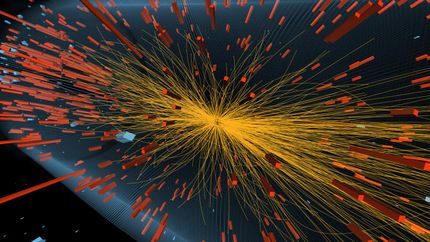Tiny drops of early universe 'perfect' fluid
Results from collisions of 3-particle ions with gold nuclei reveal evidence of primordial soup's signature particle flow
The Relativistic Heavy Ion Collider (RHIC), a particle collider for nuclear physics research at Brookhaven National Laboratory, smashes large nuclei together at close to the speed of light to recreate the primordial soup of fundamental particles that existed in the very early universe. Experiments at RHIC have shown that this primordial soup, known as quark-gluon plasma (QGP), flows like a nearly friction free "perfect" liquid. New RHIC data just accepted for publication in the journal Physical Review Letters now confirm earlier suspicions that collisions of much smaller particles can also create droplets of this free-flowing primordial soup, albeit on a much smaller scale, when they collide with the large nuclei.
"These tiny droplets of quark-gluon plasma were at first an intriguing surprise," said Berndt Mueller, Associate Laboratory Director for Nuclear and Particle Physics at Brookhaven. "Physicists initially thought that only the nuclei of large atoms such as gold would have enough matter and energy to set free the quark and gluon building blocks that make up protons and neutrons. But the flow patterns detected by RHIC's PHENIX collaboration in collisions of helium-3 nuclei with gold ions now confirm that these smaller particles are creating tiny samples of perfect liquid QGP."
"The idea that collisions of small particles with larger nuclei might create minute droplets of primordial quark-gluon plasma has guided a series of experiments to test this idea and alternative explanations, and stimulated a rich debate about the implications of these findings," said University of Colorado physicist Jamie Nagle, a co-spokesperson of the PHENIX collaboration at RHIC. "These experiments are revealing the key elements required for creating quark-gluon plasma and could also offer insight into the initial state characteristics of the colliding particles."
Definitive tests
Observations triggered the idea of testing for flow patterns in a range of more tightly controlled experiments, which is only possible at RHIC, where physicists can collide a wide variety of ions to control the shape of the droplets of matter created. With additional deuteron-gold collisions already in hand, the RHIC scientists set out to collide three-particle helium-3 nuclei (each made of two protons and one neutron) with gold-and later, single protons with gold.
The analysis of those events, as described in the new paper, reveals that the helium-gold collisions exhibit a triangular pattern of flow that the scientists say is consistent with the creation of three tiny droplets of QGP. They also say the data indicate that these small particle collisions could be producing the extreme temperatures required to free quarks and gluons-albeit at a much smaller, more localized scale than in the relatively big domains of QGP created in collisions of two heavy ions.
There are other key signatures of QGP formation, such as the stopping of energetic particle jets, which have not been detected in the tiny droplets. And other theoretical explanations suggest the flow patterns resulting from some of the small particle-nucleus collisions could emerge from the interactions of gluons within the colliding particles, rather than from the formation of QGP.
Most read news
Other news from the department science

Get the chemical industry in your inbox
From now on, don't miss a thing: Our newsletter for the chemical industry, analytics, lab technology and process engineering brings you up to date every Tuesday and Thursday. The latest industry news, product highlights and innovations - compact and easy to understand in your inbox. Researched by us so you don't have to.





























































